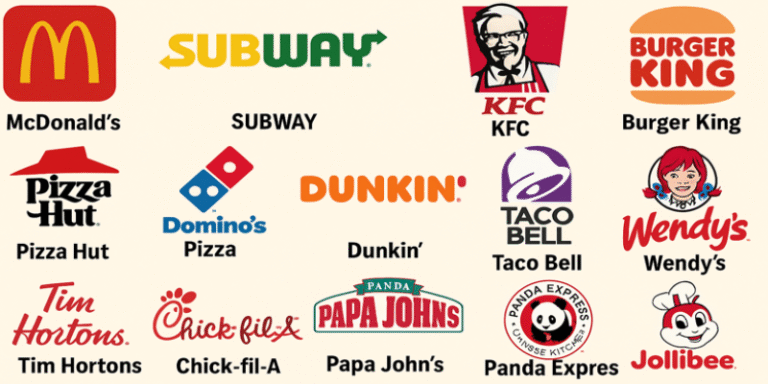Fast food has become an integral part of global culture, offering speed, convenience, and familiarity across borders. From busy urban centres to remote service stations, fast food chains are omnipresent and have redefined how people eat, travel, and socialise. This article explores the top 15 global fast food chains, examining their origins, expansion strategies, cultural impact, and influence on the food industry.
1.0 McDonald’s
Arguably the most recognised fast food brand in the world, McDonald’s operates over 40,000 restaurants globally (McDonald’s Corporation, 2023). Founded in 1940 in California, its “Speedee Service System” revolutionised food delivery through efficiency and standardisation (Ritzer, 2011). The chain is often viewed as a symbol of American capitalism and globalisation (Watson, 2006), while also adapting menus to local cultures.
2.0 Subway
With more than 36,000 outlets, Subway is the largest single-brand restaurant chain by number of locations (Statista, 2024). Known for its customisable sandwiches, Subway appeals to health-conscious consumers and has succeeded by embracing flexible franchising models (Just, 2020). However, its brand has faced setbacks due to controversies and changing dietary preferences.
3.0 Starbucks
While more of a café than a traditional fast food outlet, Starbucks holds global dominance in the coffee segment, with over 35,000 stores in 80+ countries (Starbucks, 2023). It offers premium beverages in a casual environment and is credited with shaping the modern “coffeehouse experience” (Thompson and Arsel, 2004).
4.0 KFC (Kentucky Fried Chicken)
Founded by Colonel Harland Sanders in the 1930s, KFC has become synonymous with fried chicken worldwide. With 25,000+ stores in 145 countries, it is especially successful in Asia, where it tailors flavours and promotions to local tastes (Yum! Brands, 2023). Its emphasis on quality control and supply chain integration has supported sustainable growth (Ghemawat, 2001).
5.0 Burger King
Burger King, known for its flame-grilled Whopper, is McDonald’s chief global competitor, with around 19,000 outlets (Burger King, 2024). Founded in 1954, it relies heavily on aggressive marketing and product innovation to attract younger audiences (Taylor, 2020). However, inconsistent service and franchise challenges have hindered its dominance.
6.0 Pizza Hut
Part of Yum! Brands alongside KFC and Taco Bell, Pizza Hut operates around 18,000 locations (Yum! Brands, 2023). It has successfully transitioned from dine-in restaurants to digital delivery and takeaway. Its global appeal lies in menu diversity, offering everything from stuffed crusts in the US to seafood-topped pizzas in Asia (Watson, 2006).
7.0 Domino’s Pizza
Domino’s has outpaced Pizza Hut in several key markets through its emphasis on technology and logistics. With over 19,000 stores, its “30-minute delivery guarantee” and advanced online ordering system helped set a new standard for convenience (Forbes, 2022). It invests heavily in AI and predictive analytics to optimise delivery and customer experience.
8.0 Dunkin’
Rebranded from “Dunkin’ Donuts,” this American chain has more than 13,000 outlets worldwide (Dunkin’, 2023). It specialises in coffee and baked goods and is particularly strong in the northeastern US and parts of Asia. Its strategy has shifted towards mobile ordering and co-branding with convenience stores (Just, 2020).
9.0 Taco Bell
Known for its American take on Mexican cuisine, Taco Bell has over 8,000 stores, mostly in the United States but expanding rapidly in international markets (Yum! Brands, 2023). The brand targets Gen Z with irreverent humour, bold flavours, and limited-time offerings (Ritzer, 2011).
10.0 Wendy’s
Founded in 1969, Wendy’s differentiates itself through its “fresh, never frozen beef” and square burgers. With 7,000+ outlets globally, the brand is growing rapidly in Asia and Europe (Wendy’s, 2023). It has embraced digital marketing and ghost kitchens to expand without high overheads (TechCrunch, 2022).
11.0 Tim Hortons
A Canadian favourite, Tim Hortons blends fast food with café culture, offering coffee, doughnuts, and sandwiches. With over 5,700 stores, it has expanded into the Middle East and Asia (RBI, 2023). Its cultural significance in Canada is unmatched, often considered part of national identity (Klein, 2010).
12.0 Chick-fil-A
Operating primarily in the United States, Chick-fil-A is known for its chicken sandwiches and exceptional customer service. It has around 3,000 locations and is one of the most profitable chains per unit (QSR Magazine, 2024). However, it has faced criticism over its conservative political affiliations (Wilkins, 2019).
13.0 Papa John’s
With about 5,500 outlets, Papa John’s emphasises “better ingredients, better pizza.” It ranks among the top pizza chains globally and is increasingly tech-focused, investing in digital loyalty and automation (Papa John’s, 2023).
14.0 Panda Express
An American-Chinese chain, Panda Express has around 2,400 outlets, mostly in the US, but with growing presence in the UAE, South Korea, and Mexico. Known for dishes like Orange Chicken and Chow Mein, it occupies a unique niche as a “fast casual” Chinese dining experience (Wang, 2018).
15.0 Jollibee
Founded in the Philippines, Jollibee is Southeast Asia’s biggest fast food brand. With about 1,500 stores globally, it’s rapidly expanding into the US, UK, and Middle East. Its sweet-style spaghetti, fried chicken, and rice meals cater to Asian palates while building global brand equity (Jollibee Foods Corp, 2024).
Comparison of Major Fast Food Chains Worldwide
| Rank | Chain | Headquarters | Global Locations | Notable For |
| 1 | McDonald’s | USA | ~40,000+ | Iconic Golden Arches, global market leader |
| 2 | Subway | USA | ~36,000+ | Customisable sandwiches, strong international presence |
| 3 | Starbucks | USA | ~35,000+ | Premium coffee beverages, café experience |
| 4 | KFC | USA | ~25,000+ | Fried chicken, strong in Asia and Africa |
| 5 | Burger King | USA | ~19,000+ | Flame-grilled burgers, Whopper icon |
| 6 | Pizza Hut | USA | ~18,000+ | Pizzas, family dining, part of Yum! Brands |
| 7 | Domino’s Pizza | USA | ~19,000+ | Delivery focus, pizza tech innovation |
| 8 | Dunkin’ | USA | ~13,000+ | Coffee and donuts, strong U.S. East Coast presence |
| 9 | Taco Bell | USA | ~8,000+ | Tex-Mex, youth branding |
| 10 | Wendy’s | USA | ~7,000+ | Fresh, never frozen beef, square patties |
| 11 | Tim Hortons | Canada | ~5,700+ | Coffee and baked goods, dominant in Canada |
| 12 | Chick-fil-A | USA | ~3,000+ | Chicken sandwiches, strong customer service |
| 13 | Papa John’s | USA | ~5,500+ | Pizza delivery, quality ingredients focus |
| 14 | Panda Express | USA | ~2,400+ | American-Chinese cuisine, mall-based success |
| 15 | Jollibee | Philippines | ~1,500+ | Filipino-style fast food, global expansion |
The top global fast food chains have changed the way the world eats. While they represent innovation and cultural exchange, they also embody the challenges of modern consumption—from health concerns to labour issues. As consumer preferences shift toward ethical and healthier choices, these chains must continue to adapt while managing the delicate balance between profit, public responsibility, and cultural sensitivity
References
Burger King (2024) About Us. [online] Available at: https://www.bk.com [Accessed 24 Jul. 2025].
Dunkin’ (2023) Company Information. [online] Available at: https://www.dunkindonuts.com [Accessed 24 Jul. 2025].
Forbes (2022) How Domino’s Pizza Became A Tech Company That Happens To Sell Pizza. [online] Available at: https://www.forbes.com [Accessed 24 Jul. 2025].
Ghemawat, P. (2001) ‘Distance still matters’, Harvard Business Review, 79(8), pp.137–147.
Jollibee Foods Corporation (2024) Annual Report 2024. [online] Available at: https://www.jollibee.com.ph [Accessed 24 Jul. 2025].
Just, D. (2020) Introduction to Food and Economics. London: Routledge.
Klein, N. (2010) No Logo: Taking Aim at the Brand Bullies. 2nd ed. London: Picador.
Love, J.F. (1995) McDonald’s: Behind the Arches. New York: Bantam Books.
McDonald’s Corporation (2023) Global Sustainability Report. [online] Available at: https://corporate.mcdonalds.com [Accessed 24 Jul. 2025].
Nestle, M. (2013) Food Politics: How the Food Industry Influences Nutrition and Health. Berkeley: University of California Press.
Papa John’s (2023) Investor Relations. [online] Available at: https://www.papajohns.com [Accessed 24 Jul. 2025].
QSR Magazine (2024) Top 50 Fast Food Brands by Revenue. [online] Available at: https://www.qsrmagazine.com [Accessed 24 Jul. 2025].
RBI (Restaurant Brands International) (2023) Tim Hortons Overview. [online] Available at: https://www.rbi.com [Accessed 24 Jul. 2025].
Ritzer, G. (2011) The McDonaldization of Society. 6th ed. Los Angeles: Sage Publications.
Schlosser, E. (2001) Fast Food Nation: The Dark Side of the All-American Meal. Boston: Houghton Mifflin.
Starbucks (2023) Annual Report 2023. [online] Available at: https://www.starbucks.com [Accessed 24 Jul. 2025].
Statista (2024) Leading Fast Food Chains Worldwide. [online] Available at: https://www.statista.com [Accessed 24 Jul. 2025].
Taylor, K. (2020) The Burger Wars: Competition in the Fast Food Industry. Journal of Business Strategy, 41(2), pp.121–132.
Thompson, C. and Arsel, Z. (2004) ‘The Starbucks Brandscape’, Journal of Consumer Research, 31(3), pp.631–642.
Wang, Y. (2018) Globalising Asian-American Cuisine: Panda Express and the Fast Casual Revolution. Gastronomica, 18(2), pp.21–29.
Watson, J.L. (2006) Golden Arches East: McDonald’s in East Asia. 2nd ed. Stanford: Stanford University Press.
Wendy’s (2023) Company Growth and Development Report. [online] Available at: https://www.wendys.com [Accessed 24 Jul. 2025].
Wilkins, A. (2019) Culture Wars and Corporate Values: Chick-fil-A and Public Perception. Sociological Inquiry, 89(4), pp.645–659.
Yum! Brands (2023) Annual Report. [online] Available at: https://www.yum.com [Accessed 24 Jul. 2025].









